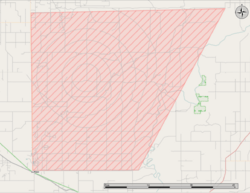CFB Suffield facts for kids
Quick facts for kids
CFB Suffield
BFC Suffield (French)
|
|||||||||||
|---|---|---|---|---|---|---|---|---|---|---|---|

CFB Suffield in Alberta. The north edge of the base is over 40 km (25 mi) long.
|
|||||||||||
| Summary | |||||||||||
| Airport type | Military | ||||||||||
| Owner | Government of Canada | ||||||||||
| Operator | Department of National Defence | ||||||||||
| Location | Cypress County, Alberta | ||||||||||
| Built | 1971 | ||||||||||
| Commander | LCol C. D. Claggett | ||||||||||
| Occupants | Defence Research and Development Canada British Army Training Unit Suffield |
||||||||||
| Time zone | MST (UTC−07:00) | ||||||||||
| • Summer (DST) | MDT (UTC−06:00) | ||||||||||
| Elevation AMSL | 2,525 ft / 770 m | ||||||||||
| Coordinates | 50°16′24″N 111°10′30″W / 50.27333°N 111.17500°W | ||||||||||
| Map | |||||||||||
| [[Helipad|]] | |||||||||||
|
|||||||||||
|
Source: Canada Flight Supplement
Environment Canada |
|||||||||||
Canadian Forces Base Suffield (also known as CFB Suffield) is a large Canadian Forces base. It is home to the biggest army training area in Canada. You can find it in southeastern Alberta, about 50 km (31 mi) northwest of Medicine Hat. It's also about 250 km (160 mi) southeast of Calgary. A public road, Highway 884, goes right through the base.
The base even has its own radio station, CKBF-FM. This station plays programs for both Canadian and British military members who are stationed there. A small village called Ralston is also located on the base lands.
Contents
History of CFB Suffield
Early Land Use and Research
The land that is now CFB Suffield was once known as the "Suffield Block." It wasn't very good for farming because the weather was often dry. Some people tried to settle there, but many farms were left empty during the dry years of the 1920s.
In 1941, during World War II, the British Army needed a new place to test how to protect against chemical weapons. They had used a facility in French Algeria, but it was no longer available. So, the Canadian government bought the Suffield Block. About 452 residents had to move from their homes. On June 11, 1941, the "Experimental Station Suffield" officially opened.
After 1946, Canadian forces took over the operation. In 1947, the facility was handed over to the Defence Research Board, which is now called Defence Research and Development Canada. The name changed a few times, becoming "Suffield Experimental Station" in 1950 and then "Defence Research Establishment Suffield" (DRES) in 1967. The Canadian Army still used the training areas sometimes during these years.
Airfield Operations
Around 1942, an airfield was built at Suffield. It was used by the Royal Canadian Air Force (RCAF). This airfield had a hard-surfaced runway, which was about 4,660 ft (1,420 m) (1.4 km) long.
British Army Training in Canada
On August 25, 1971, the Canadian and British governments made an agreement. This allowed the British Armed Forces to use the northern part of the Suffield Block for large-scale training. They could practice with tanks, infantry, and artillery.
On December 1, 1971, Canadian Forces Base Suffield (CFB Suffield) was officially created. Many staff, buildings, and vehicles were moved to the new base. The Crown Village of Ralston also became part of CFB Suffield. By January 1972, the British Army Training Unit Suffield (BATUS) was set up. The first live training shot was fired by a British army unit on July 15, 1972.
British Army training has continued at Suffield ever since. The agreement has been extended many times. Since 1991, Canadian Army units also started using the base for their training. BATUS has special training equipment and a team that acts as the "enemy force" for exercises.
In 1996 and 1997, two buildings at CFB Suffield were recognized as federal heritage buildings. These were the Central Laboratory and Ralston School. In 2000, DRES became part of a new organization called Defence Research and Development Canada (DRDC).
Defence Research and Development Canada, Suffield
Defence Research and Development Canada (DRDC) is an important agency. It works for the Canadian Department of National Defence. DRDC helps the Canadian Forces with their scientific and technological needs. Its main goal is to make sure the Canadian Forces stay advanced and effective.
DRDC has eight research laboratories, and one of them is DRDC Suffield. This lab is a leader in research for chemical and biological defence. It also works on military engineering, how military vehicles move, and how to test weapon systems.
Wildlife Refuge Area
When the Suffield Block became a military training area in 1941, a large part of the prairie grassland was left untouched. This meant it was protected from farming and other industrial activities. In 1992, the military signed an agreement with Environment Canada.
In 2003, a big area of land along the South Saskatchewan River was set aside. This area, about 458 square kilometres (177 sq mi), was named the Suffield National Wildlife Area. It helps protect the natural environment and wildlife in the region.


